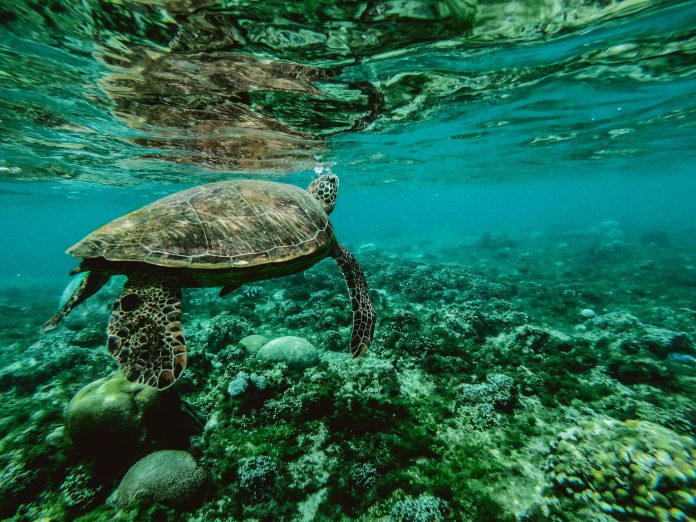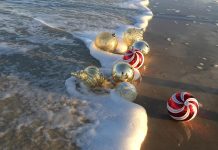Recently the World Seagrass Association with the help of GRID-Arendal, United Nations Environmental Program (UNEP) and UNEP World Conservation and Monitoring Center (UNEP WCMC) released a report on the importance of conserving seagrass. All six Dutch Caribbean islands host this vital habitat and this report emphasizes the need for local governments to invest in protecting these areas.
Seagrass can be found on all six of the Dutch Caribbean islands, especially Aruba, Bonaire and St. Eustatius which have large seagrass fields. Curaçao, St. Maarten and Saba also have seagrass, but on a much smaller scale. Recently researchers have been able to estimate the distribution of seagrass around Bonaire, Saba and St. Eustatius, as well as Curaçao, however the estimations around Curaçao vary wildly from nearly 800ha in a 2003 study to no extensive seagrass habitats in a 2015 study. Nature Foundation St. Maarten has been monitoring their local seagrass fields, noting their recovery especially after significant hurricane events which can devastate these environments. Aruba is also working to improve their knowledge on local seagrass through research conducted within the newly formed Parke Marino Aruba.
As we continue to learn about the importance of these habitats, it really highlights the need for the Dutch Caribbean to invest in understanding these environments so we can ensure conservation plans are designed and implemented to meet the specific needs of each island.
Importance of Seagrass
Seagrass fields are some of the most biologically rich and productive environments in the world. They can be found on six continents and in waters ranging from the warm tropics to the freezing artic. These underwater fields play critical roles in the environment, serving as natural water filters, nursery beds and habitat for a variety of marine creatures, and acting as critical carbon sinks (storing up to 18% of the world’s oceanic carbon). In addition, seagrass fields offer protection to coral reefs by providing a buffer for ocean acidification and pollution along with acting as the first line of defense along coasts through anchoring sand and reducing wave energy thus minimizing beach erosion and storm damage. On top of all of this, these habitats provide important cultural benefits through the tourism and recreational opportunities they create.
Current State
The current state of seagrasses is quite alarming. Recent research estimates that globally, nearly 7% of seagrass is being lost each year; or around one football field every 30 minutes. The biggest threats to these habitats are human led, with agricultural and industrial run-off, coastal development and the effects of climate change being the most significant issues. Paired with physical damage caused by unregulated fishing, anchoring, trampling and dredging, the remaining beds are in drastic need of intervention. In fact, the 2017 State of Nature report, published by Wageningen University assessed the conservation status of seagrass fields within the Caribbean Netherlands as “very unfavorable”. The report specifically called out issues related to physical damage caused by tourist activities such as wading, surfing and sailing. In addition, this report sited issues associated with climate change such as sea level rise, increased sea temperature and intensifying of storms and algal blooms further threatens these areas. Global Synthesis Report The World Seagrass Association’s global synthesis report hopes to bring attention to these issues by stressing the importance of these habitats to policy makers while providing advice on ways to mitigate future losses. Their goal was to show how through a combination of conservation projects, sustainable management and restoration efforts these critical habitats can be preserved for future generations. This report boasts seven key findings; most centered on the importance of these habitats and the fact that human led actions are the biggest threats. This report stressed the need for the development and implementation of policies and management to protect the remaining seagrass beds, most of which can be leveraged off proven strategies which have already been implemented.
Recommendations
13 key recommendations were present to better understand the current state of seagrass, design and implement conservation strategies and help guide policy makers to create new legislation to support these efforts. Current State Recommendations 1-4 are focused on understanding the current state of seagrass beds on a global level. This includes creating a policy expert group to analyze the effectiveness of current policies and recommend improvements for the future. They also state that it is important to develop comprehensive seagrass maps to fully appreciate their current state and global distribution along with investing in research to better understand and quantify the value of ecosystem services these habitats provide. Lastly, they recommend a campaign to raise awareness and communicate the importance of seagrass to educate the public on the value and importance of protecting these habitats.
Policy Changes
Recommendations 5-9 focus on integrating seagrass conservation strategies into local and international action plans. This includes strategies for hitting targets at the national and international level such as those set by the UN’s 17 Sustainable Development Goals, Paris Agreement, Convention on Biological Diversity and Sendai Frameworks. Increasing Conservation Efforts Lastly, recommendations 10-13 focus on ways to improve conservation efforts through increasing stakeholder involvement and increased support through funding and legislative actions. These recommendations highlight the importance of action across all levels. Increasing stakeholder involvement from the individual through the governmental level is the only way to ensure enduring long-term success of these conservation efforts. Currently, only 26% of all known seagrass fields are protected, so increasing Marine Protected Areas (MPAs) or Locally Managed Marine Areas (LMMAs) is a vital step towards protecting these environments.
Future of Seagrass
Although these habitats have been in slow decline since the 1930s, thanks to human led conservation efforts, there are many areas where these trends are slowing down or even reversing. The future of these important habitats is dependent on the continuation and expansion of these conservation efforts across all levels. Immediate conservation efforts are needed to restore and conserve remaining seagrass habitats. Larger infrastructure changes will be required to minimize human impact of nearshore environments, including limiting pollution, minimizing the impact of coastal development and improvements to waste water treatment. Together we all can play an important role in improving the water quality that is necessary for these habitats to thrive.
















